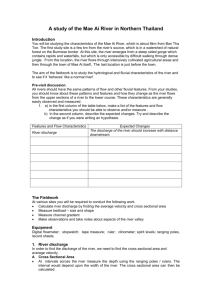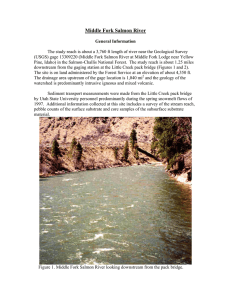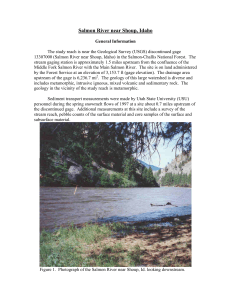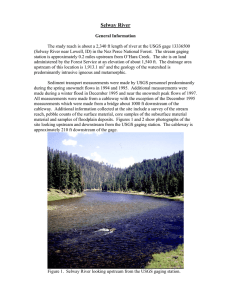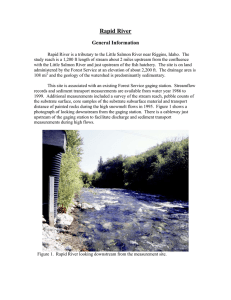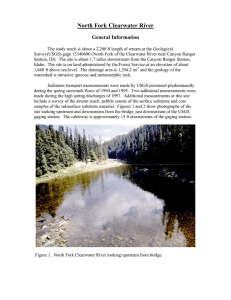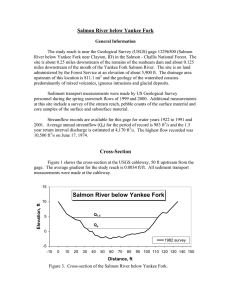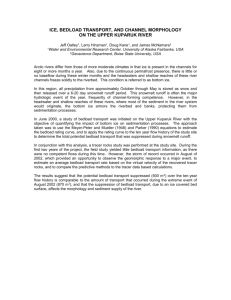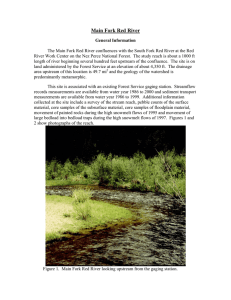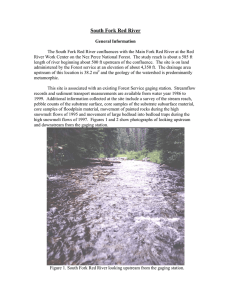Big Wood River General Information
advertisement
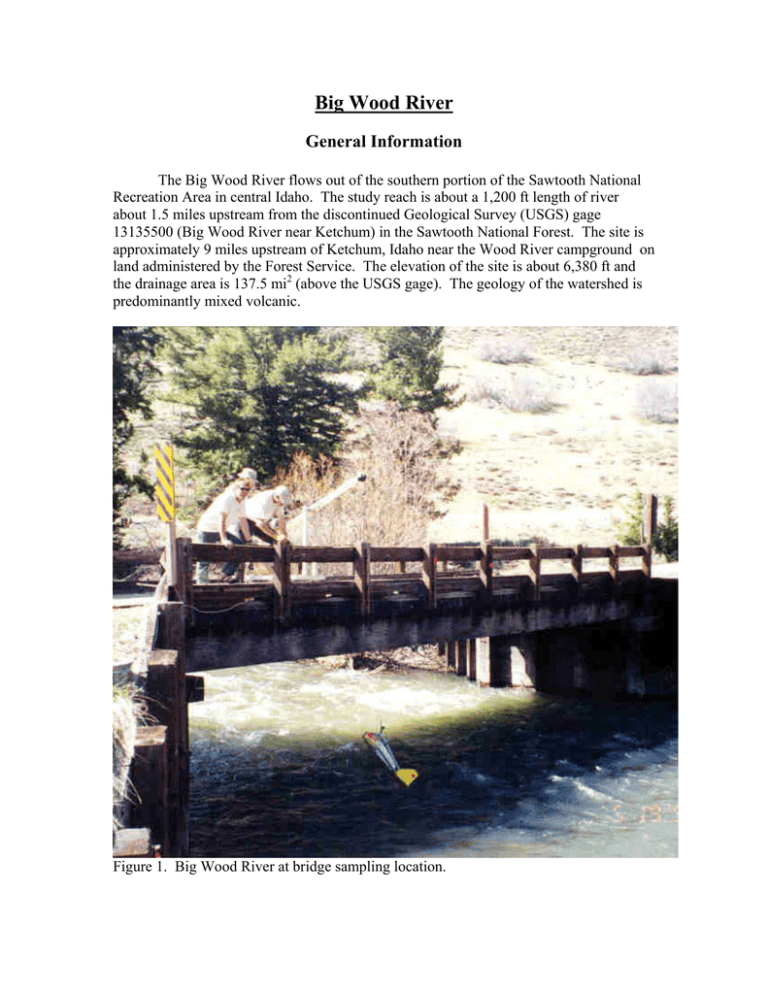
Big Wood River General Information The Big Wood River flows out of the southern portion of the Sawtooth National Recreation Area in central Idaho. The study reach is about a 1,200 ft length of river about 1.5 miles upstream from the discontinued Geological Survey (USGS) gage 13135500 (Big Wood River near Ketchum) in the Sawtooth National Forest. The site is approximately 9 miles upstream of Ketchum, Idaho near the Wood River campground on land administered by the Forest Service. The elevation of the site is about 6,380 ft and the drainage area is 137.5 mi2 (above the USGS gage). The geology of the watershed is predominantly mixed volcanic. Figure 1. Big Wood River at bridge sampling location. In 1999 and 2000 personnel of Utah State University measured sediment transport and instantaneous streamflow at this site (Figure 1). Additional information collected at this site include a survey of the stream reach, pebble counts of the substrate surface and core samples of the substrate subsurface material. Streamflow records for complete water years are available for this site 1949 through 1971. The minimum and maximum daily mean discharge for the period of record are 15 ft3/s and 1,510 ft3/s, respectively. Estimated average annual streamflow (Qa) is 167 ft3/s and the estimated 1.5 year return interval discharge (Q1.5) is 772 ft3/s. The maximum discharge recorded was 1,690 ft3/s on May 24, 1967. Cross-Section Elevation, ft Figure 2 shows the cross-section at the sediment transport measurement site at the bridge shown in Figure 1. The average gradient for the study reach is 0.0091 ft/ft. 8 7 6 5 4 3 2 1 0 -1 -2 Big Wood River Q1.5 Qa -5 0 5 10 15 20 25 30 35 40 45 Distance, ft Figure 2. Cross-section of Big Wood River at the sediment transport measurement site. Channel Geometry The channel geometry relationships for this cross-section are shown in Figure 3. All data collected by USU personnel in 1999 and 2000 were used to develop the displayed power relationships with discharge. Width is constant at this bridge location over the measured range of discharge. Over the range of discharges when sediment transport was measured (213 to 1,090 ft3/s) estimated average depth and estimated average velocity varied from 1.36 to 3.60 ft, and 3.7 to 7.2 ft/s, respectively. The average reach gradient is 0.0091 ft/ft. 10 100 Average Velocity 0.403 y = 0.432x 2 R = 0.92 Big Wood River Average Velocity, ft/s Width and Depth, ft Top Width y = 41.85 10 Average Depth 0.597 y = 0.055x 2 R = 0.96 1 100 1 10000 1000 3 Discharge, ft /s Figure 3. Width, average depth and average velocity versus stream discharge at the measurement cross section on the Big Wood River. Channel Material A pebble counts were made along three transects in the study reach and three cores of surface and subsurface material were collected, one at each transect in July 2000. The D50 and D90 for the combined pebble counts were 119 mm and 353 mm, respectively (Figure 4). The D50 and D90 for the combined subsurface cores were 25 mm and 152 mm, respectively, and for the combined surface cores were 155 mm and 210 mm, respectively. 100 Big Wood River 90 80 Percent Finer 70 60 50 40 30 20 2000 Pebble Counts 2000 Subsurface Cores 2000 Surface Cores 10 0 0.1 1 10 100 1000 10000 Particle Size, mm Figure 4. Particle size distribution for surface and subsurface material samples in the Big Wood River. Sediment Transport Sediment transport measurements made in 1999 and 2000 includes 100 measurements of bedload transport and 26 measurements of suspended sediment transport. Sediment transport measurements spanned a range of stream discharges from 213 ft3/s (1.28Qa; 0.28Q1.5) to 1,090 ft3/s (6.53Qa; 1.41Q1.5). Bedload transport ranged from 0.0462 to 371 t/d and suspended transport ranged from 26.0 to 1,400 t/d. Over the range of discharges when both bedload and suspended load transport rates were measured, suspended transport accounts for the majority of the material in transport with over an order of magnitude greater suspended transport than bedload transport at the lower discharges and about six times as much at the highest discharge (Figure 5). 10000 Big Wood River Suspended 2.982 y = 4.650E-07x 2 R = 0.82 BCF=1.102 Sediment Transport, tons/day 1000 Total Bedload 3.540 y = 1.534E-09x 2 R = 0.87 BCF=1.300 100 10 1 Qa 0.1 100 Suspended Total Bedload Q1.5 1000 Discharge, ft3/s Figure 5. Bedload and suspended load transport rate versus discharge. 10000 The bedload transport rates by size class (Figure 6) shows that the larger rates are usually associated with material in the 0.5 to 2mm diameter size class. 1000 Big Wood River Bedload Rate, tons/day 100 0.5-2mm 3.216 y = 5.283E-09x 2 R = 0.89 <0.5mm 0.5-2mm 2-8mm 8-32mm >32mm 10 <0.5mm 3.081 y = 2.225E-09x 2 R = 0.92 2-8mm 3.680 y = 1.457E-10x 2 R = 0.84 1 8-32mm 4.311 y = 1.486E-12x 2 R = 0.72 >32mm 1.551 y = 1.804E-04x 2 R = 0.37 0.1 Qa 0.01 100 Q1.5 1000 Discharge, ft3/s Figure 6. Bedload transport rate versus discharge for selected size classes. 10000 The size of the largest particle in the bedload sample increased with discharge (Figure 7). The largest particle measured in a bedload sample was 79 mm at a discharge of 1,000 ft3/s. At discharges greater than the 1.5 year return interval discharge (772 ft3/s) the largest particle always exceeded 22 mm. There is also a trend of increasing median size of the bedload sample with increasing discharge. The D50 for most of the bedload samples collected at discharges less than the 1.5 year return interval discharge were in the sand size, 0.5 to 2.0 mm. The information on the largest particle in the bedload sample suggests that discharges somewhat larger than the 1.5-year return interval discharge are capable of moving the median diameter particles on the channel surface. 1000 Big Wood River near Ketchum D50 for three surface pebble counts 100 Bedload Size, mm R2 = 0.63 D50 for three subsurface cores 10 R2 = 0.08 1 Qa Median Size Largest Particle Q1.5 0.1 10 100 1000 10000 Discharge, ft3/s Figure 7. Median size of the bedload sample and the largest particle size versus stream discharge for the Big Wood River.

